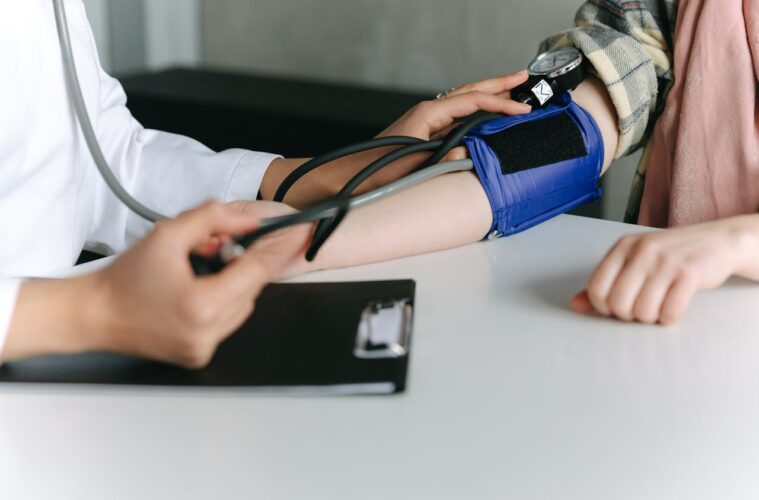High blood pressure, or hypertension, is a common yet serious condition that increases the risk of heart disease, stroke, and kidney problems. While medication is often prescribed, lifestyle and dietary changes can play a significant role in lowering blood pressure naturally.
If you’ve been diagnosed with high blood pressure or are looking to prevent it, this comprehensive guide will provide actionable steps to help you improve your heart health and maintain optimal blood pressure levels.
Understanding Blood Pressure: What Is It and Why Does It Matter?
Blood pressure is the force exerted by blood against the walls of the arteries. It is measured in millimeters of mercury (mmHg) and presented as two numbers:
- Systolic pressure (the top number): Measures the pressure in arteries when the heart beats.
- Diastolic pressure (the bottom number): Measures the pressure in arteries when the heart is at rest between beats.
A normal blood pressure reading is typically around 120/80 mmHg. High blood pressure is classified as follows:
- Elevated blood pressure: 120–129 / below 80 mmHg
- Stage 1 hypertension: 130–139 / 80–89 mmHg
- Stage 2 hypertension: 140 or higher / 90 or higher mmHg
Prolonged high blood pressure can damage arteries, leading to heart disease, stroke, and kidney problems. Thankfully, there are many effective ways to bring your blood pressure down naturally.
1. Improve Your Diet: The Best Foods to Lower Blood Pressure
Diet plays a crucial role in blood pressure management. Eating the right foods can help lower blood pressure and improve overall cardiovascular health.
Follow the DASH Diet
The Dietary Approaches to Stop Hypertension (DASH) diet is widely recommended for reducing blood pressure. It emphasizes:
✅ Fruits and vegetables: High in potassium, which helps balance sodium levels.
✅ Whole grains: Provide fiber, which promotes heart health.
✅ Lean proteins: Fish, chicken, and plant-based proteins like beans and lentils.
✅ Healthy fats: Nuts, seeds, and olive oil.
✅ Low-fat dairy: Helps reduce blood pressure without excess saturated fats.
Reduce Sodium Intake
Excess sodium causes the body to retain water, increasing blood pressure.
Aim for less than 2,300 mg of sodium per day (1 teaspoon of salt).
If possible, lower it to 1,500 mg per day for even better results.
Tips to Reduce Salt Intake:
- Avoid processed foods (canned soups, frozen meals, chips, and fast food).
- Check food labels for sodium content.
- Use herbs and spices instead of salt for flavor.
Increase Potassium-Rich Foods
Potassium helps balance sodium levels in the body and relaxes blood vessels.
Top Potassium Sources: Bananas, oranges, spinach, avocados, sweet potatoes, and beans.
Eat Magnesium-Rich Foods
Magnesium helps relax blood vessels and improve circulation.
Great Sources: Dark leafy greens, nuts, seeds, whole grains, and fish.
Limit Sugar and Refined Carbs
Diets high in sugar and refined carbohydrates can contribute to obesity and insulin resistance, increasing blood pressure.
Opt for:
✔ Whole grains instead of white bread or pasta.
✔ Natural sugars from fruits instead of sweets and sugary drinks.
2. Maintain a Healthy Weight
Excess weight puts extra strain on the heart, leading to higher blood pressure.
✅ Losing 5–10% of your body weight can significantly lower blood pressure.
How to Achieve a Healthy Weight:
- Reduce portion sizes.
- Eat more fiber-rich foods (keeps you full longer).
- Stay active (see exercise section below).
- Avoid processed foods (they often contain unhealthy fats and sugars).
 3. Exercise Regularly
3. Exercise Regularly
Regular physical activity strengthens the heart and helps lower blood pressure.
Best Exercises for Blood Pressure Control
Cardio Workouts: Brisk walking, cycling, swimming, or jogging for 150 minutes per week.
Strength Training: Lifting weights 2–3 times a week helps improve circulation.
Yoga and Stretching: Helps with relaxation and stress reduction.
If you’re new to exercise, start with 30 minutes of walking daily and gradually increase intensity.
4. Reduce Stress Levels
Chronic stress contributes to high blood pressure.
Here’s how to manage stress effectively:
Practice mindfulness and meditation: Just 5–10 minutes per day can lower stress hormones.
Engage in relaxing activities: Reading, listening to music, or spending time in nature.
Get enough sleep: Aim for 7–9 hours of quality sleep per night.
Limit caffeine and alcohol: Both can increase blood pressure in some individuals.
5. Quit Smoking and Reduce Alcohol Intake
Smoking and excessive alcohol consumption spike blood pressure levels and damage blood vessels.
Quitting smoking lowers blood pressure and reduces the risk of heart disease.
Limit alcohol to:
- Men: No more than 2 drinks per day
- Women: No more than 1 drink per day
6. Monitor Your Blood Pressure Regularly
Check your blood pressure at home with a digital monitor.
Track your readings and share them with your doctor.
Schedule regular check-ups to stay on top of your heart health.
7. Consider Natural Supplements
Certain supplements may help lower blood pressure:
Garlic extract: Known for its heart-health benefits.
Omega-3 fatty acids: Found in fish oil, reduces inflammation and blood pressure.
Green tea extract: Contains antioxidants that support heart health.
⚠ Always consult your doctor before starting any supplements.
Final Thoughts: Take Control of Your Blood Pressure Naturally
High blood pressure is a serious condition, but it is manageable and reversible with the right lifestyle changes. By adopting a heart-healthy diet, exercising regularly, reducing stress, and making other positive changes, you can significantly lower your blood pressure and improve your overall well-being.
Start today—your heart will thank you! ❤️


 3. Exercise Regularly
3. Exercise Regularly